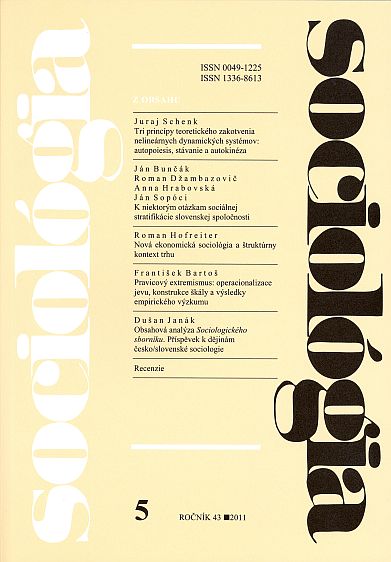K niektorým otázkam sociálnej stratifikácie slovenskej spo-ločnosti
On some Questions of Social Stratification in Slovak Society
Author(s): Anna Hrabovská, Roman Džambazovič, Ján Buček, Ján SopóciSubject(s): Social Sciences
Published by: SAV - Slovenská akadémia vied - Sociologický ústav
Keywords: social stratification; social class; EGP class scheme; International Socio-Economic Index of Occupations (ISEI); subjective placement in the stratification system of society
Summary/Abstract: On some Questions of Social Stratification in Slovak Society. The present study deals with the following groups of questions regarding changes in the social stratification system in Slovak society: 1.How has the social stratification system changed? Which of the classes has more members and which of them less? How do they differ? How has the relationship between gender and social status changed? 2. Do class members differ in their values, attitudes, needs, beliefs and lifestyles? Are these classes potential social classes with specific characteristics and features, making possible to create a class identity? The analysis is based on the results of social stratification research in Slovakia in 1993 – 2010. The theoretical basis was the Goldthorpe EGP class scheme. The first group of questions can be answered as follows: during the last twenty years the vertical social order has changed. The highest level – the level of service class, which includes higher-grade professionals and managers – was joined with the category of economically independent individuals, the category with the biggest increase of members. The most dramatic decrease of members was in the category of skilled manual workers. The long-term decrease in the proportion of agricultural workers continues. The differentiation between EGP classes is bigger and the income is not the only significant aspect. There is still a strong gender differentiation in social status; gender has a stronger impact on the amount of income than does EGP class. The answer to the second question is: members of the three EGP classes have different opinions on some of the basic economic issues and how to handle them. In addition, they also differ in how they deal with their own economic situation, and thus with an important part of their lives. It can be assumed that these classes (or at least some of them) may become real social classes. Sociológia 2011, Vol. 43 (No. 5: 495-527)
Journal: Sociológia - Slovak Sociological Review
- Issue Year: 43/2011
- Issue No: 5
- Page Range: 495-527
- Page Count: 33
- Language: Slovak

